Chapter 4 – What is directing this plan?
Public Engagement
Public engagement was an essential part of the update to the Statewide Multimodal Transportation Plan. The transportation system exists to meet the needs of the people and businesses in Minnesota. It is important to understand what those needs are and use that information to guide decision-making. It is also important that everyone is able to participate and be heard.
A high-level summary of engagement is included in the following sections. More detailed information can be found in Appendix D.
Phase 1
The engagement approach for this plan update was organized into two phases. The first phase focused on connecting with the general public and transportation partners. Phase 1 was the primary phase of engagement. It began in August 2015 and continued through March 2016. Almost all engagement activities were conducted jointly with the Minnesota 20-Year State Highway Investment Plan, which was being updated at the same time. The two plans also shared a joint website.
The first phase of engagement asked about the future of the state and transportation. To plan for the future, it is important to understand what Minnesotans wanted the plan to focus on. To do this, MnDOT asked participants about a number of changes projected for Minnesota over the next 20 years. These shifts – in the economy, environment, population, technology and transportation behavior – will affect how people and goods move. The goal was to understand which of these changes, or types of changes, were most important for the plan to consider moving forward. Participants helped prioritize more than 20 individual trends in five different areas:
Environmental Trends
Transportation Behavior Trends
Population Trends
Economic Trends
- Economic Sectors & Employment Patterns
- Freight Rail in Minnesota
- Aging Infrastructure
- Public-Private Partnerships
- New Logistics
- Dynamic Road Pricing
Technology Trends
Phase 1 engagement at a glance
- August 2015 through March 2016
- 125+ in-person events
- 7,500+ website sessions
- 300,000+ social media views/impressions
- 12,450+ responses
Activities
The first phase of engagement included a variety of in-person and online opportunities for Minnesotans to get involved. Figure 4-1 highlights all the tactics that were used. More information about each activity is available in Appendix D.
Figure 4-1: Summary of engagement tactics

Audience
More than 12,450 responses were received during the first phase of engagement. Participants were asked to answer a few optional and anonymous demographic questions. They were asked about their age, race / ethnicity, gender and zip code. This information helped to make sure overall participation mirrored the make-up of Minnesota. When asked, about 56 percent of participants provided at least some demographic information. Figure 4-2 and Figure 4-3 show who was reached during this engagement effort.
Figure 4-2: Demographic comparison between respondents and Minnesota’s population
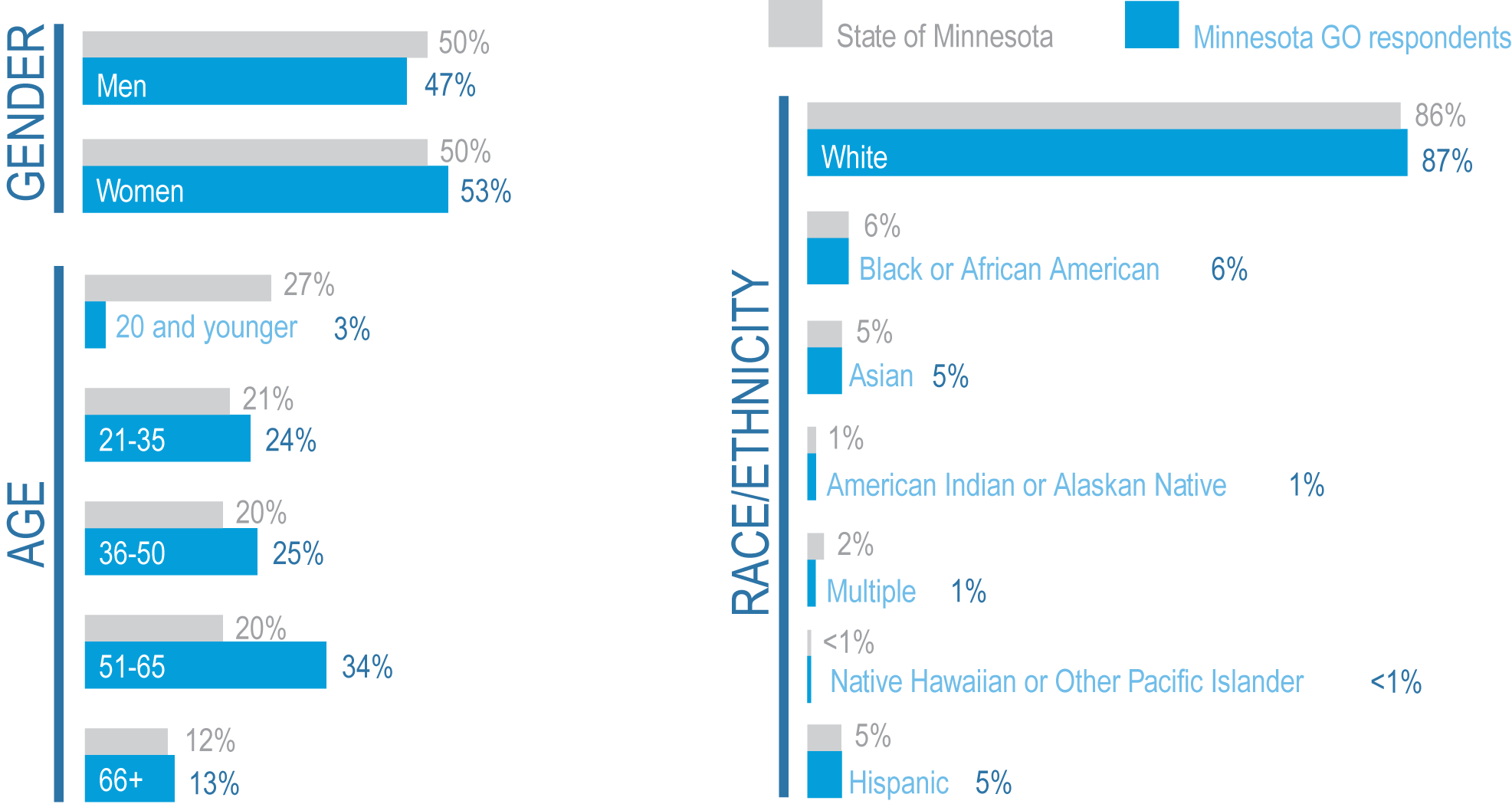
Figure 4-3: Phase 1 participation by zip code
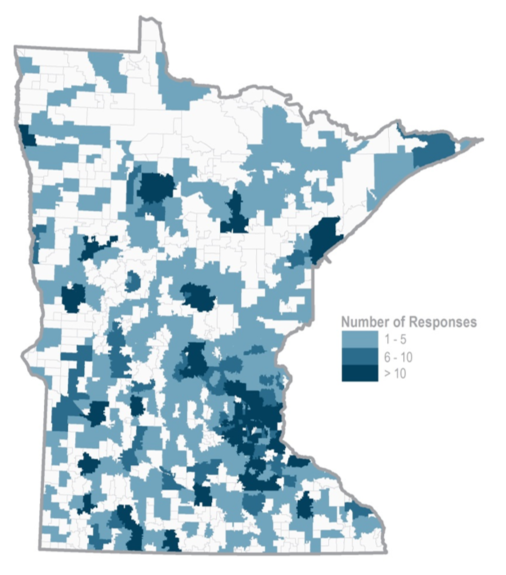
Results
A summary of input from Phase 1 is included in the following sections. More detailed information can be found in Appendix D.
Trend Categories
Environmental trends were more frequently identified as the most important area of change to plan for. Approximately 30 percent of all participants chose this as their top priority. Environmental changes were followed by changes in transportation behavior and population changes, which were both the top priority for approximately 20 percent of respondents (Figure 4-4).
Figure 4-4: Percent of respondents identifying a trend category as their top priority
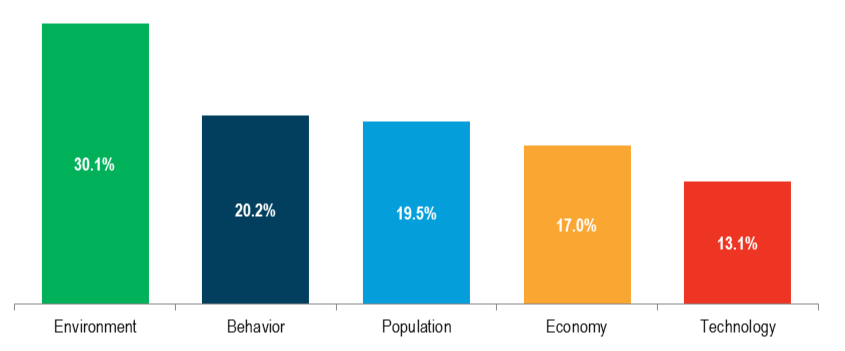
This overall relative priority provided some direction. However, not every respondent shared the same priorities. Demographic data was used to identify trend areas that were a higher priority for one group than the collective ranking. Key differences include:
- Transportation behavior changes were a higher priority among these groups: transportation partners, men, Asian Minnesotans, White Minnesotans, and age groups 21-35, 36-50, 51-65 and 66 plus.
- Population changes were a higher priority for American Indian or Alaska Native Minnesotans.
- Economic changes were a higher priority among these groups: transportation partners, men, American Indian or Alaska Native Minnesotans, Asian Minnesotans, Black or African American Minnesotans, Hispanic Minnesotans, and Minnesotans of multiple races / ethnicities.
- Technology changes were a higher priority among transportation partners, American Indian or Alaska Native Minnesotans, and Minnesotans age 20 and under.
This data indicates potential differences among demographic groups, but it is important to remember that this is a summary. There are many different perspectives and opinions within all communities in Minnesota.
Individual Trends
In addition to ranking each trend category, participants were asked to identify which individual trends are most important to them. The goal was to understand if there are specific trends that may be a high priority even if the broader category was seen as less important. The five most-prioritized individual trends are shown in Figure 4-5.
Figure 4-5: Top five most important individual trends
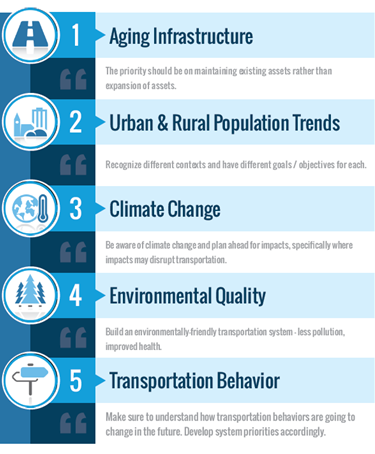
Generally speaking, the top individual trends are closely linked to the top priorities among the broader trend areas. Similar to the broader trend areas, there were variations in how participants prioritized the individual trends. Key differences include:
- The aging population trend was ranked in the top five for American Indian or Alaska Native Minnesotans and Minnesotans older than age 65.
- The economy and employment trend was ranked in the top five for Minnesotans of multiple races / ethnicities.
- The mobility as a service trend was ranked in the top five for Minnesotans ages 20 and younger.
- Health trends in Minnesota were ranked in the top five for American Indian or Alaska Native Minnesotans and Hispanic Minnesotans.
- The electrification and alternative fuels trend was ranked in the top five for Black or African American Minnesotans and Minnesotans ages 20 and younger.
- The racial disparities and equity trend was ranked in the top five for Black or African American Minnesotans and Hispanic Minnesotans.
- The sensors, monitors and big data trend was ranked in the top five for Minnesotans ages 20 and younger.
Again, while this data indicates potential differences among demographic groups, it is important to remember that these numbers are summaries. There are many different perspectives and opinions within all communities in Minnesota.
Impact
The input received from Phase 1 helped determine what the policy direction in the plan should focus on. The priority areas and trends identified by Minnesotans were reviewed to make sure they are reflected in the bjectives and strategies (Chapter 5). For example, climate change and environmental quality were identified as top priorities. There are now two new strategies related to climate change: one to reduce emissions from the transportation sector and one to identify risks to the transportation system, such as more frequent flooding.
Phase 2
The second phase of engagement occurred during April and May 2016 and built on the information gathered in Phase 1. A number of specific questions rose up as the priorities from Phase 1 were incorporated into policy direction. These questions covered a range of topics and mostly dealt with the details about how the proposed changes would be implemented. Given this focus on implementation, Phase 2 primarily focused on reaching transportation partners, including different groups within MnDOT. However, even with a focus on transportation partners, anyone was welcome to participate. The major topics covered in this phase of engagement included:
- Land use and transportation connections
- Urban and rural system performance
- Equity and ability
- Climate change and environmental quality
Activities
Given the focus on reaching transportation partners, stakeholder forums were the primary engagement tactic used in Phase 2. Four stakeholder forums and a webinar forum were held. For those who were not able to attend one of the forums or the webinar, an online survey version of the questions was available on the project website. Materials were also provided to planning partners, who were asked to share the information with their networks. More information about each activity is available in Appendix D.
Results
The following sections summarize the responses related to the four topics covered in Phase 2. More detailed information can be found in Appendix D
Land Use and Transportation Connections
Nearly three out of four participants in Phase 2 expressed support for developing context guidance as part of the SMTP work plan. Context guidance refers to tying land use, community development and population factors to various aspects of transportation planning. This may include incorporating context considerations into public engagement strategies, road design, cost sharing and more. Participants were also asked about tying different types of spending to land use considerations. Generally speaking, there was support for prioritizing bicycle and pedestrian spending and safe routes to school funding in this way. However, there was greater support for this among MnDOT participants and less support among other transportation partners.
Urban and Rural System Performance
Participants were also asked to provide input related to how MnDOT and transportation partners track and report system performance. Currently, most reporting is done at a statewide level. However, there may be reasons to consider reporting some measures separately for urban and rural areas. This would help ensure the needs in both contexts are being addressed. Participants supported reporting measures separately by urban and rural for asset management, safety and mobility performance measures. This approach would also require better guidance on what is meant by “urban.” There was no consensus among participants on how to define urban areas. Generally speaking, MnDOT participants expressed a preference for a population-based definition. Other partners generally supported a definition that includes more factors than just population, such as employment or retail activity. In general, MnDOT and partner participants expressed concern about MnDOT’s ability to adequately address urban highway corridors in the future given the pressures of maintaining an aging highway network.
Equity and Ability
Participants generally supported explicitly addressing equity and individual ability in this plan. The majority of participants favored MnDOT continuing to research how the transportation system can best advance equity in communities. Many participants also supported exploring strategies to increase workforce diversity in the transportation sector and piloting approaches to incorporate equity into transportation decision-making.
Climate Change and Environmental Quality
Consistent with Phase 1 results, participants expressed support for addressing climate change and environmental quality issues in this plan. There was strong support for assessing the vulnerability of transportation infrastructure to environmental factors related to climate change. To a lesser degree, participants expressed support for all transportation partners moving forward with strategies to reduce greenhouse gas emissions, reestablishing a MnDOT flood mitigation program, and setting targets for salt use in winter maintenance. There was general support for adopting the 2007 Next Generation Energy Act targets for greenhouse gas emissions specifically for the transportation sector. However, the level of support varied among different partners and different geographies.
Impact
The input from Phase 2 was used to make edits to the objectives, performance measures and strategies in this plan (Chapter 5). The input also helped to identify and prioritize key activities to be included in the near-term work plan (Chapter 6). For example, consistent with the input related to the land use and transportation connections discussion, the work plan includes developing tools and resources to support transportation decisions that reflect the surrounding context. Additionally, the input from Phase 2 will also continue to inform the implementation of this plan into the future.
State and Federal Requirements
For many years, there have been state and federal requirements for statewide transportation plans. These requirements include updating the plan every four years. The plan must support national, state and local goals such as economic development and environmental protection. MnDOT is responsible for working with the public, local governments, metropolitan planning organizations, regional development organizations, tribal governments and other transportation partners to produce a 20-year plan that sets statewide policy direction and guidance. Over the years, these requirements shifted from an exclusive focus on automobiles and trucks to an approach that considers the many ways people and goods travel.
The following sections describe how innovation and new policy direction shaped this plan.
Purpose of Transportation Planning
- No related sections.
Transportation shapes the ways communities develop. The current transportation system required vast investment of public and private resources over decades. The system also requires a substantial amount of funding to maintain and continue operating. Changes in community needs and desires mean that the system needs to change over time.
Transportation planning is complex. It relies on many different groups working together. The process blends technical analysis, public expectations and input from public and private transportation partners. This blended information is used to identify priorities, choices and risks to the system. It is also used to distribute resources for future investments. Long-range planning is required to be eligible for federal and state transportation funding assistance. It is especially important given the billions of dollars invested in the system each year.
Federal direction for statewide transportation plans requires a multimodal approach that:
- Supports economic vitality in ways that enhance global competitiveness
- Increases safety and security of the transportation system for all users
- Improves accessibility and mobility for both people and freight
- Fosters environmental protection, energy conservation and coordination between transportation and local plans
- Improves connections between transportation modes
- Achieves efficient system operations and management
- Emphasizes preservation of the existing transportation system
- Improves the resiliency and reliability of the transportation system and reduces or mitigates stormwater impacts of surface transportation
- Enhances travel and tourism.[1]
Minnesota law requires a similar focus on safety, system condition, the importance of transportation for the economy and compatibility with state environmental goals. The state also has goals for transit access, reasonable commutes and bicycling and walking.[2]
Minnesota law requires MnDOT to update the Statewide Multimodal Transportation Plan every four years. Federal planning regulations require the Statewide Multimodal Transportation Plan to plan at least 20 years into the future.
Appendix F provides links to both federal and state law as they pertain to this plan.
Changes in Approach and Emphasis
- No related sections.
Performance-Based Planning
MnDOT began using performance measures to inform management and investment decisions inthe mid-1990s. In 2003, MnDOT adopted the first performance-based statewide transportation plan in the nation. Performance measures show how well the system is functioning. Targets communicate desired outcomes. Performance measures cover all modes, system assets and operations. A few examples include crash rates, fatalities, roadway and bridge condition, and age of transit vehicles. MnDOT carefully considers existing commitments, priorities and tradeoffs when adding or changing performance measures and targets. All adopted performance measures and targets are included in MnDOT’s annual performance report.
At the federal level, the 2012 Moving Ahead for Progress in the 21st Century Act established national performance measures related to the National Highway System, safety, congestion, emissions and freight movement. MAP-21 required states to develop performance-based plans and to coordinate with metropolitan planning organizations when developing performance targets. These requirements were continued under the 2015 Fixing America’s Surface Transportation Act. To date, final rules have been issued for safety performance management. Proposed rules have been issued for pavement and bridge performance measures and for system performance measures. These categories include measures related to the National Highway System, freight movement on the interstate system and the Congestion Mitigation and Air Quality Improvement Program.
The Significance of Freight
Federal transportation planning requirements shifted in the early 1990s. One part of this shift was an increased emphasis on the role that freight plays in the economy. Freight’s role in the transportation system was again highlighted in MAP-21. MAP-21 required the establishment of freight-related performance measures. The FAST Act further emphasizes freight by directing the U.S Department of Transportation to designate a national multimodal freight network and develop a national freight strategic plan. The FAST Act also requires states to develop state freight plans and encourages states to create freight advisory committees.
Much work has been done to better understand Minnesota’s freight system and the investment needs of the state’s ports, waterways, highways, rail and airports. Since 2012, MnDOT updated the State Aviation System Plan, State Rail Plan and Statewide Freight System Plan. MnDOT also adopted its first Statewide Ports and Waterways Plan. These plans help show how goods move across the state and reach local, regional, national and international destinations.
Cooperation & Consultation
The 1990s shift in federal direction also required that statewide planners cooperate and consult with many different transportation partners. To meet these new requirements, Minnesota created the area transportation partnerships, which bring local, regional, state and tribal interests together within each MnDOT district. The ATPs collaboratively decide priorities for available federal transportation funding. There is considerable variation in total membership from one ATP to another and each ATP includes city, county, metropolitan planning organization and regional development organization representatives. American Indian tribes within an ATP have the option to participate on the ATP. For the Twin Cities area, the Metropolitan Council’s Transportation Advisory Board functions as the metro area ATP. Figure 4-6 shows the eight ATP districts. Figure 4-7 identifies the regional development organizations and metropolitan planning organizations in Minnesota.
Figure 4-6: Minnesota’s area transportation partnerships
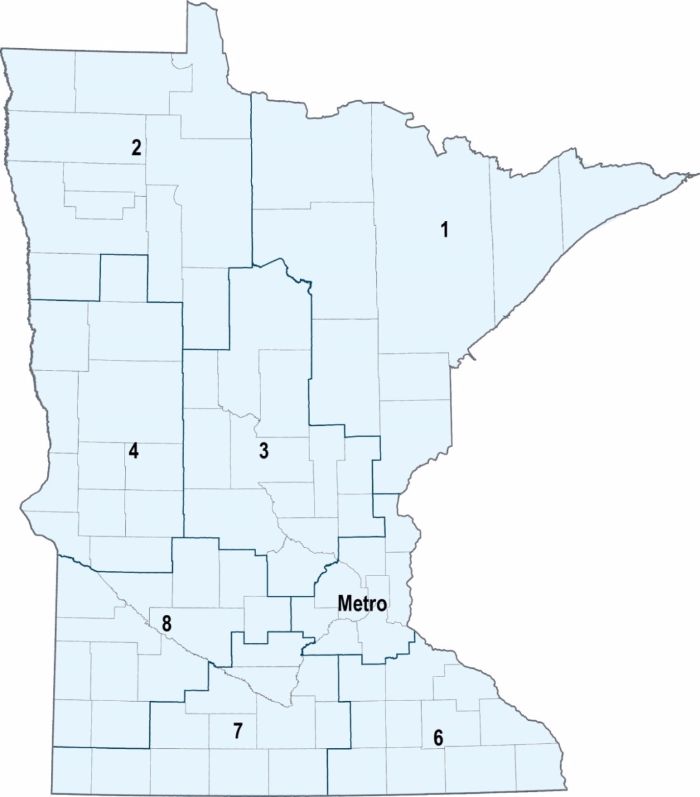
Figure 4-7: Minnesota’s metropolitan planning organizations and regional development organizations
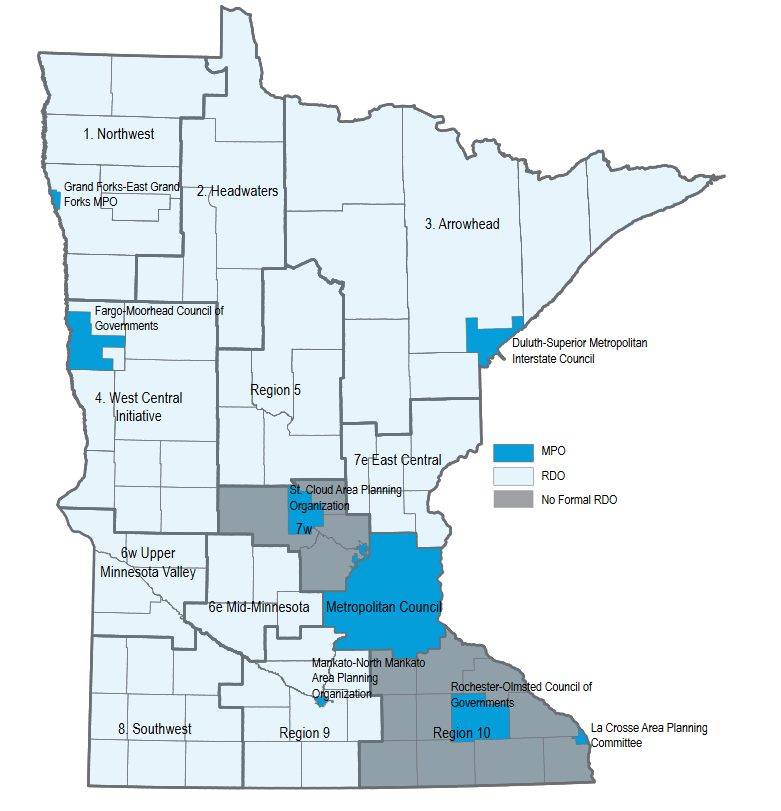
The sovereignty of tribes was formally recognized through a 2002 accord between Minnesota’s tribes, MnDOT and the Federal Highway Administration. The accord established commitments for regular consultation. State executive orders in 2005 and 2013 reinforced the government-to-government character of relationships between tribes and the state.
Environmental Justice
Title VI of the 1964 Civil Rights Act prohibits discrimination on the basis of race, color and national origin in federally assisted programs and activities. A 1994 Presidential Executive Order on Environmental Justice requires agencies to identify and address the effects of all programs, policies and activities on minority and low-income populations.[3] Environmental justice improves decision-making by ensuring that public agencies treat people fairly and involve them in a meaningful way during the development and implementation of transportation plans and projects. Appendix E provides an analysis of the potential impacts the objectives and strategies identified in Chapter 5 may have on the state’s environmental justice populations.
Olmstead Plan
Olmstead plans are named after a U.S. Supreme Court decision that held that the unjustified segregation of people with disabilities violates the Americans with Disabilities Act. The plans describe how public entities will meet their obligation to provide individuals with disabilities opportunities to live, work and be served in integrated settings.
In 2012, Minnesota began working on its Olmstead Plan. The Minnesota Olmstead plan identifies a method for Minnesota state agencies to document their plans to provide services to people with disabilities. Transportation is a key aspect of an individual’s independence and quality of life. The Minnesota Olmstead Plan assumes that the need for available and accessible transportation applies to all modes of transportation. However, the plan recognizes that much of the transportation need relates to transit services. It identifies strategies to meet the plan’s vision for transportation – “People with disabilities will have access to reliable, cost-effective and accessible transportation choices that support the essential elements of life such as employment, housing, education and social connections.”[4]
Complete Streets
Streets and roadways are inherently multimodal. They accommodate the travel of people using cars, trucks, buses, emergency vehicles and bicycles and those walking. The complete streets approach to road planning and design considers and balances the needs of all users. The goal is to provide a system that is accessible and equitable to all, regardless of how they choose to travel. MnDOT adopted a complete streets policy in 2013 and updated the policy in 2016. MnDOT uses a complete streets approach in system-level planning, project scoping and design, operations, and maintenance. Several Minnesota cities, counties and planning organizations have developed similar policies.
Other Plan Review
As part of this update process, MnDOT’s other statewide transportation plans and the long range transportation plans prepared by Minnesota’s metropolitan planning organizations and tribal nations were reviewed. The purpose of the review was to identify key trends and policy objectives and to consider how those trends and objectives may impact this plan update. The identified trends were addressed in the trend analysis described in Chapter 3. The policy objectives were considered as the plan’s objectives and strategies were reviewed and updated (Chapter 5). Summaries of the reviews are included in Appendix G.
1 Federal planning factors, 23 USC 135(d)(1)
2 State transportation goals, Minnesota Statute 174.01
3 Executive Order 12898, Federal Actions to Address Environmental Justice in Minority and Low-Income Populations
4 Putting the Promise of Olmstead into Practice: Minnesota’s Olmstead Plan, August 10, 2015, http://www.dhs.state.mn.us/main/groups/olmstead/documents/pub/dhs16_196300.pdf
